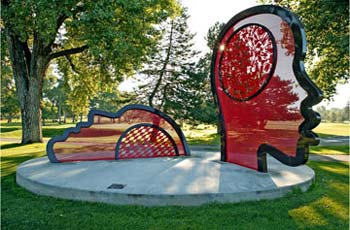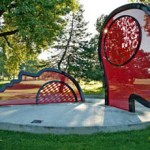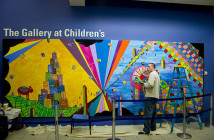In order to celebrate its 35th birthday, the Boston Center for the Arts showcased artists from its studios, past and present. The show, Studios@35, held in the BCA’s Mills Gallery was curated by local art hero and celebrity, James Manning.
There are 56 studios (or thereabouts) at the BCA, and artists must apply to get on a waiting list for a studio. The BCA rents each of the 50 non-live-in studios for $11/square foot, which is out of the price range of most young artists, though in some cases rental costs are split between two or more artists. $11/square foot is a relative bargain considering the location, included utilities, month to month lease and the intangible benefits of immersion in the supportive community of the BCA. The remaining six studios are live/work spaces only available to artists earning less than $37,570 a year.
The show is fairly typical of the BCA: inclusive and not-exactly revolutionary, excluding much of the work by Mills Gallery Director Laura Donaldson, who’s been polishing this pearl of an art-space for about 3 years now. For the first half of the noughties, the majority of the Mills’ most successful shows were juried exhibitions where the jurors (Annette Lemieux, Bill Arning, Raphaela Platow, etc.) drew more attention than the artists. But not to criticize the curator, who, though given carte blanche in formulating the show, was limited not only to current and former BCA studio artists, but to those that took the time to submit work for his consideration.
The sheer number of studios and the application process alone would, one would think, make for a great show. Manning sorted through 35 years and, potentially, 56 studios worth of artists to put the show together, but I was underwhelmed. I trust his judgment, so when he stated that his “approach to the show was simple; let each artist bring their best to the table,” it means that the work in the show is the best work made available to him from 56 studios across 35 years. I think it is disappointing that not all the work in the show is from current studio artists and furthermore that much of it was not even created while they were at the BCA. Was there not enough work to fill the 2200 square foot gallery? The significance of the BCA is lost on works that were created long after an artist left the BCA, even more if they were only there for one or two years. Jim Cambronne, one of the more notable move-ins in the last 2 years, had work included in the show that was created in 2000 and 1999. Isn’t that cheating? Also strange is the fact that there are six live/work spaces, but only one artist in the show, Jen Roberts, who uses that space. In fact, she is the only artist listed on the BCA’s site as being located in the live/work space. Are all the studios even filled? Are they too expensive for artists? If they are, can the BCA seek out grants to supplement more of the costs? I suggest they follow the lead of an org like the Berwick Research Institute, which with far less money and a tiny fraction of the BCA’s assets, has turned out about 20 future stars over the past five years with its non-residency Artist in Research program.
One would expect a group of studios in an area that has undergone a relative renaissance over the past couple decades to wield an amazing group of artists. One would think that the BCA’s spaces would be highly sought after and the competition would wield a variety of highly successful artists. The blame can only fall on 35 years of lackadaisical management on the part of the BCA’s administrators. The BCA purports itself to be nurturing, but in some cases, artists have been in a studio for decades without advancing their career, showing much work or raising the profile of the BCA and Boston. Guidelines which the BCA has implemented over the past few years, such as a reapplication process after 3 years, are encouraging professionalism amongst the artists and increasing the competitiveness of the selection process. So things are improving, but in the meantime, the turnover of the studios is pre-global-warming glacial.
Indeed it was the most recent move-ins to the BCA studios who contributed the more memorable work to Studios@35. Meryl Hamilton, who arrived in 2002, created large laminated prints (Tawana and Precious – both 2006) of racially charged news articles about crimes. She blew the prints up to 2 feet by 6 feet and laid them on the ground with chalk outlines surrounding them, implying that the victims of the crimes were victims of poor media coverage as well as a crime. Douglas Kornfeld’s (a 2001 move-in) public art pieces are all wholesome, creative and accessible; and on view throughout the country. It’s nearly impossible to show his work in a gallery, but the small 8x10 photographs of his works, which were untidily taped to the gallery wall, left much to be desired. Mary Derr and Lazaro Montano, who coincidentally share a studio and both use grids in their work were 2004 arrivals. Derr’s pieces, Defective Heart and Defective Pretzel (both 2006) are canvases hung from the ceiling so that both sides can be viewed. They are visually compelling products of a negotiation between gesture and process. Lazaro Montano’s People Magazine’s 50 Most Beautiful People of 2002 (2006) features all 50 ‘Beautiful’ people that Montano individually printed on grids of 20 short stacks of ‘post-it’ note-pads all pealing back and revealing the same image printed on each successive level of ‘post-it’ note.
Miriam Shenitzer was the only BCA "veteran" who caught my eye. Having held a studio at the BCA for 10 years, she pales in comparison to those that have been at BCA since it was founded, but has been through the various stages of the BCA during the years of some of it most significant growth and change. Her line drawings of various sea creatures and their corresponding rhyming caricature (Eel/Shlemiel, Trout/Kraut, Dyke/Pike, etc.) are all rendered in a very straightforward, even childlike, fashion. The simplicity of the drawing, coupled with the rhyming of fish to stereotypes, enable her to further cartoonize a stereotype to hilarious ends while reminding us how early in life we learn our biases.
In the end, the show does reflect a diversity Manning sought to highlight among the artists. In curating a variety of works, as well as those from artists who long ago departed BCA’s studios, Manning helped us understand the effect the BCA had on artists, the community and beyond as well as the historical importance of the BCA. However, he also revealed how the BCA has not lived up to its full potential over its 35-year lifespan.
Links:
Boston Center for the Arts
Boston Center for the Arts Artists Studios
"Studios@35" was on view November 17, 2006 - January 7, 2007 at the Mills Gallery of the Boston Center for the Arts.
All images are courtesy of the artists and the Boston Center for the Arts.





